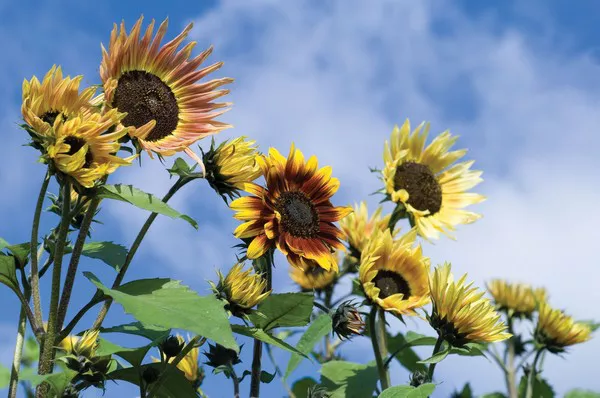Embarking on the journey of cultivating sunflowers is an exciting endeavor for many garden enthusiasts. The anticipation of vibrant blooms and the cheerful presence of these iconic flowers can make the process truly rewarding. Understanding the timeline of sunflower growth, specifically how long it takes for sunflowers to sprout, is a crucial aspect of successful cultivation.
The Sunflower Seed: A Tiny Marvel
At the heart of every sunflower’s growth journey lies the humble seed. Sunflowers are renowned for their large, distinctive seeds, each containing the potential for a magnificent bloom. The first stage of the journey begins with selecting high-quality sunflower seeds. Opting for seeds from reputable sources and ensuring they are viable and healthy sets the stage for a successful cultivation experience.
Planting Sunflower Seeds: Setting the Stage
The process of nurturing sunflowers starts with planting the seeds in the right conditions. Sunflowers are known for their love of sunlight, requiring at least six to eight hours of direct sunlight each day. Choose a location in your garden that receives ample sunlight and has well-drained soil. Plant the seeds at a depth of approximately one to one-and-a-half inches, and make sure to space them adequately to allow for proper growth. Water the soil consistently to keep it moist, providing the optimal environment for the seeds to germinate.
Germination: The Sunflower’s Awakening
The germination stage marks the beginning of the sunflower’s transformation from seed to sprout. This process typically takes about 7 to 10 days, although variations may occur based on factors like temperature and soil conditions. During germination, the seed absorbs water, causing it to swell and eventually crack open. A tiny root emerges, followed by the appearance of the first leaves—the initial signs of the sunflower’s journey toward maturity.
Factors Influencing Germination Time
Several factors play a crucial role in determining how quickly sunflowers will sprout during the germination stage. Soil temperature is a significant influencer, with warmer soil generally promoting faster germination. Aim for a soil temperature between 70 and 78 degrees Fahrenheit for optimal results. Additionally, the quality of the soil and the moisture level are pivotal factors. Consistent watering without over-saturation is essential to create the ideal conditions for germination.
Cotyledons and True Leaves: Early Growth Phases
As the sunflower seedlings emerge from the soil, they first develop cotyledons, which are the embryonic leaves that provide the initial energy for the young plant. These are not the true leaves of the sunflower but serve as the plant’s first source of nutrition. Following the cotyledons, the true leaves start to emerge, signifying the beginning of the sunflower’s independent ability to photosynthesize and generate energy.
The Heightening Growth Spurt: Weeks 2-3
In the second and third weeks of the sunflower’s growth journey, a noticeable growth spurt occurs. The plant’s stem elongates, and additional leaves unfold. During this phase, it’s essential to ensure that the sunflowers receive adequate water and nutrients. Mulching around the base of the plants can help retain soil moisture and suppress weeds, contributing to a healthier and more robust growth trajectory.
Budding and Formation of the Sunflower Head
Around the fourth to sixth weeks of growth, the sunflowers enter a critical phase where the flower head begins to form. The stem continues to elongate, and a distinctive bud emerges at the top. This bud holds the promise of the iconic sunflower bloom that gardeners eagerly anticipate. Adequate sunlight, proper watering, and well-balanced soil nutrients become increasingly crucial during this stage to support the vigorous development of the flower head.
Blooming Splendor: Weeks 8 Onward
The eighth week onward marks the pinnacle of the sunflower’s growth journey—the blooming stage. Depending on the specific sunflower variety and environmental conditions, this stage may occur earlier or later. The iconic yellow petals unfurl, creating a spectacular display of color. The blooming period typically lasts for several weeks, providing a breathtaking vista in gardens and landscapes. During this phase, it’s important to continue caring for the sunflowers by ensuring they receive sufficient water and addressing any potential pest issues.
Harvesting Sunflower Seeds: Journey Full Circle
As the blooming phase concludes, the sunflower undergoes another transformation—the transition to seed production. The vibrant flower head transforms into a seed-filled center, and the seeds mature over the following weeks. Harvesting sunflower seeds is a gratifying step that completes the growth cycle. Wait until the back of the flower head turns yellow and the seeds become plump and firm before harvesting. Once harvested, allow the seeds to dry thoroughly before storing them for future planting or culinary use.
Conclusion
In conclusion, the journey of cultivating sunflowers from seed to sprout and beyond is a captivating process that unfolds over several weeks. Understanding the various stages of growth, from germination to blooming and seed production, empowers gardeners to provide the optimal care needed for a successful outcome. As with any gardening endeavor, patience, attention to detail, and a touch of horticultural know-how are the key ingredients for a garden symphony where sunflowers take center stage, transforming a plot of soil into a vibrant sea of golden blooms.


